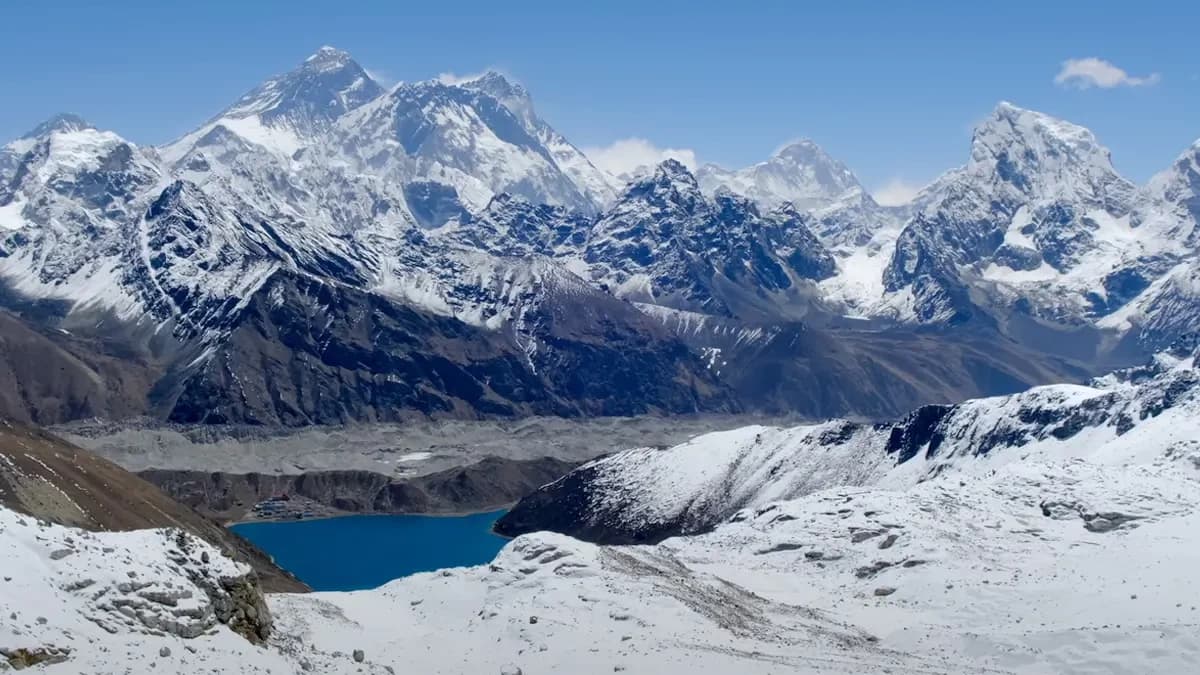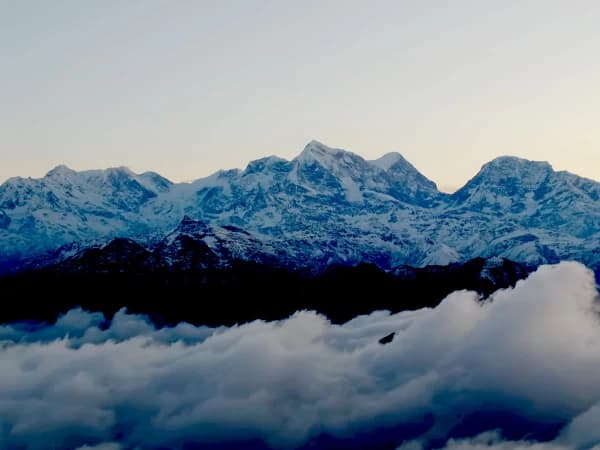The Everest Three Passes Trek is a heart-pounding experience in Nepal's legendary Everest region, which is specially designed for trekkers who are looking for tremendous challenges. The fascinating expedition brings you across three thrilling mountain passes that are Renjo La Pass (5,465m), Cho La Pass (5420m) and Kongma La Pass (5,535m), and Everest Base Camp (5,364 m) witnessing close views of Mount Everest, Lhotse, Makalu, and the Gokyo Lakes.
This adventurous trekking journey takes you to the wilderness, alpines, glaciers, high mountains, and off-the-beaten trails. At the same time, you will immerse into the passionate ethnic culture of the Himalayan people, wandering through centuries-old monasteries and picturesque regions of Himalayan villages. Although it is one of the most challenging treks in the world, the Everest Three high passes trek tests your strength but offers some of the most breathtaking views one can ever imagine.
Everest Three High Pass Trek - Highlight
- Begin your trek with the flight to Lukla which is one of the most exciting flights across the Himalayas.
- Cross three great passes Kongma La (5,535m), Cho La (5,420m), and Renjo La (5, 465m) with spectacular Himalayan views.
- Get a magnificent mountain view of Everest, Lhotse, Nuptse, Makalu, Cho Oyu, and Ama Dablam all through the trek.
- Visit the Gokyo Lakes which are the five sacred lakes that are surrounded by glaciers and offer a peaceful experience.
- A sunrise from Kala Patthar (5,545m) presents a close-up look at Mount Everest and other surrounding peaks.
- Trek to one of the world's most popular destinations, the Mount Everest Base Camp (5,364m).
- Experience the culture of the Himalayan people, monasteries prayer wheels, and charming villages of the Khumbu region.
- Visit the vibrant Namche Bazaar where there is everything from shops and bakeries to superb vistas over the Khumbu region.
- Cross through alpine forests, meadows, glaciers, and rocky hills and passes, as well as varieties of flora and fauna.
Overview - Everest Three High Pass Trek
The Everest Three Passes Trek is an outstanding expedition that provides a complete adventure through the iconic Everest region. A specially crafted adventure to test even seasoned trekkers as it traverses three challenging high-altitude passes Renjo La Pass (5,465m), Cho La Pass (5,420m), and Kongma La Pass (5,535m). Every pass has its own difficulties and offerings, giving this trail a memorable experience for every trekker.
The trek begins with a scenic flight to Lukla, you will be trekking through different terrains, through several vibrant Himalayan villages and popular landmarks including Namche Bazaar, Tengboche Monastery, and of course Everest Base Camp. The Everest Three High Pass is challenging and physically demanding with a trek in the rocky terrains with up to 6 to 8 hours in a day. It’s a trek that is perfect for trekkers who want to have an adventurous journey in the Himalayan region.
The Everest Three High Pass Trek offers unparalleled views, Renjo La Pass has striking views of Everest and pristine Gokyo Lakes, considered better than even the Kala Patthar, crossing Cho La Pass has close-up views of peaks such as Ama Dablam (6,812m) and Cholatse (6,501m), with the added element of challenge as trekkers navigate across icy trails. The Kongma La Pass, the highest of three has great panoramic views of Lhotse, Makalu, and turquoise glacier lakes.
Beyond the Everest Three Passes Trek, witness the iconic views including the sunrise view of Everest from Kala Patthar and the serene Gokyo Lakes which is the highest freshwater lake in Nepal. It also takes a look at the cultural heart of the Khumbu region with opportunities to explore vibrant and traditional Himalayan Villages, experience local hospitality, and visit monasteries deeply steeped in spiritualism.
Among all other high-altitude treks, the Everest Three High Pass Trek stands out, offering a complete exploration of the Everest region by combining destinations like Everest BaseCamp and Gokyo Lakes treks with increased challenges and rewards. In this trekking you will be experiencing a real-life transforming adventure with unmatched beauty, thrill, and cultural richness, thereby making it the ultimate adventure in the Himalayan country, of Nepal.
How Challenging is the Everest Three High Passes Trek?
The Everest Three High Passes Trek is an amazing journey that combines a lot of trekking challenges physically and mentally. Popular as one of the most challenging treks in the Himalayas. It involves crossing three major high-altitude passes i.e. Kongma La Pass at 5,535m, Cho La Pass at 5,420m, and Renjo La Pass at 5,365m. Every pass has its own set of challenges, ice casting, and harsh terrains but the Everest Three High Passes Trek stands like a dream for every seasoned trekker.
The adventurous and challenging trek takes you on a day-by-day hike through steep and beautiful mountain trails. After reaching an altitude of 5,000 meters, the thin air makes it difficult to requisite oxygen. Thus, the right preparation and acclimatization hold great significance when it comes to facing the Everest Three High Pass trek. It gets very cold at night, and the weather is also quite volatile. The snow and the wind can make the trek much more challenging.
Meanwhile, the Everest Three High Pass trek is the most rewarding one, offering the stunning panoramic views of Mount Everest, Lhotse, Makalu, and Nuptse. Crossing all three high passes makes the trek unforgettable.
Best Time for Everest Three High Passes Trek
Thebest time for trekkingto Everest's three high passes trek is during Spring (March to May) and Autumn (from September to November). This season guarantees optimal weather conditions, spectacular mountain views, and vibrant cultural interactions.
Everest Three Passes Trek in spring season: Spring brings new life into nature as different flowers bloom on the trail while meadows grow green at higher altitudes. That brings stunning views of the Himalayas when the skies are clear. It means comfortable trekking conditions as well. The season in spring makes Nepal culturally vibrant as it coincides with Maha Shivaratri and Buddha Jayanti, adding festive vibes to your trek. Additionally, both flora and fauna flourish in this season, thereby allowing various encounters along the way. The daytime temperature goes from 17 to 25°C, with the nights dropping down as low as -15°C.
Three high Passes in the autumn season: Autumn is celebrated as the ultimate trekking season. With calm, dry weather and crystal-clear skies, the views are extraordinary. The trails are in excellent condition, ensuring a hassle-free experience. The cultural highlight of this season includes the grand festivals of Nepal, Dashain and Tihar, which fall in this season. Moderate temperatures, ranging from 15°C to 20°C during the day and dropping to -10°C at night, make trekking pleasant.
While summer/monsoon (June to August) and winter (December to February) are considered off-seasons, they can be unique experiences. The monsoon time converts the landscape into a verdant haven but presents problems like rain and slippery trails. Winter greets with solitude and snow-laden trails, yet freezing temperatures demand extra preparation.
Spring and autumn are incomparable and the best seasons for an exceptional Everest Three High Passes Trek. However, other seasons of trekking in the Everest region offer a different adventure that can be great with the proper preparation.
Benefits of Joining the Everest Three Passes Trek with Touch Planet Treks
- Free airport arrival and departure transfers from/to the hotel are available on private transport.
- Easy booking and reservation system.
- Online trek briefing after booking confirmation.
- Open for customized Everest Three High Pass Trek Itinerary.
- Pre-arranged accommodation throughout the trek
- Free Everest Three High Pass Trek Map.
- 24/7 phone and WhatsApp communication at +977 9841774591
- Touch Planet Treks T-Shirt (to keep) and a Duffel Bag (for trekking Duration).
- We will provide an Oximeter for blood oxygen monitoring at high elevations to detect altitude sickness early.
- Free Medical Kits might be necessary in Certain Cases.
- Special hospitality with personalized service and care.
- Smooth trekking experience by following the safety measures.
- Seasonal fruits will be served after your dinner.
- A portion of your payment will go towards CSR efforts to help the local community.
- Free Excess Luggage Storage facility at Touch Planet Treks during the Everest Three High Passes Trek.
Everest Three High Passes Trek Cost 2026
The adventurous Everest Three High Passes Trek is an exciting trekking trip package that assures value and quality at every step of this fascinating trek in the Everest region. The Everest Three High Pass Trek costs between USD 1,700 to USD 2,200, depending on the group size and the premium service we will be providing throughout the trek. For solo trekkers, the cost of the Everest Three High Passes Trek is USD 2,085. Everest Three High Pass Trek includes everything from certified and well-experienced high-altitude trekking guides, dependable porters to carry your heavy bags, and all the permits required for the Everest Three High Pass Trek. The cost of the Everest Three High Pass Trek is reasonably set, considering the best accommodation according to altitudes, like cozy lodges along the routes of all three passes. Enjoy nutritious meals daily on the trek to keep you fuelled throughout your adventure in the Everest Region.
The cost of the Everest Three High Pass Trek includes all the transportation, flights, and accommodation facilities as per our Everest Three High Pass Trek Itinerary. The Everest Three High Pass Trek cost is based on the group size during the booking, quality accommodation, and fantastic meals that we will be providing during this pristine and peaceful high pass trek. For more information related to the Everest Three High Pass Trekking cost, please check below or WhatsApp us.
Group Everest Three High Pass Trek Cost
- Solo Everest Three High Pass Trek Cost USD 2095
- 2 to 7 Trekkers Everest Three High Pass Trek Cost USD 1990
- For 8 to 14 trekkers, the Everest Three High Pass Trek costs USD 1799.
- For a group of 15 to 20 trekkers, the Everest Three High Pass Trek costs USD 1690.














